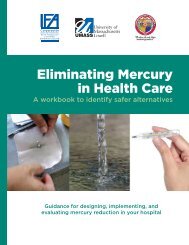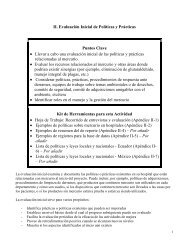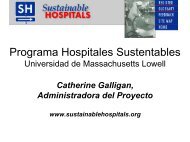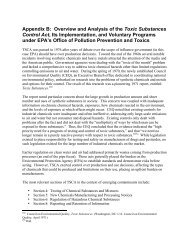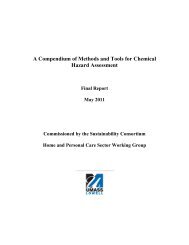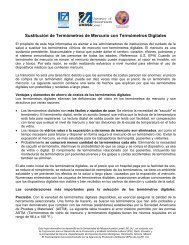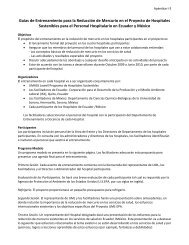Download - The Lowell Center Framework for Sustainable Products
Download - The Lowell Center Framework for Sustainable Products
Download - The Lowell Center Framework for Sustainable Products
You also want an ePaper? Increase the reach of your titles
YUMPU automatically turns print PDFs into web optimized ePapers that Google loves.
<strong>The</strong> <strong>Lowell</strong> <strong>Center</strong> <strong>Framework</strong> <strong>for</strong> <strong>Sustainable</strong> <strong>Products</strong> | 17<br />
<strong>Lowell</strong> <strong>Center</strong> Projects to Promote<br />
<strong>Sustainable</strong> <strong>Products</strong><br />
Lead-free electronics<br />
Although lead is a well-established human and environmental hazard, it is still used in many products such as printed<br />
circuit boards in electronics products. Lead has remained the preferred material on printed circuit boards <strong>for</strong> the past 60<br />
years because of its proven reliability. To help the electronics industry find alternatives to lead, the Toxics Use Reduction<br />
Institute (TURI) and the University of Massachusetts <strong>Lowell</strong> convened the New England Lead-Free Electronics<br />
Consortium. <strong>The</strong> Consortium is a collaborative ef<strong>for</strong>t of industry, government, and academia.<br />
<strong>The</strong> <strong>Framework</strong> <strong>for</strong> <strong>Sustainable</strong> <strong>Products</strong> helps guide this ef<strong>for</strong>t. <strong>The</strong> goal of the project is to eliminate lead in consumer<br />
electronics products, which will make these products healthier <strong>for</strong> consumers. By removing lead from manufacturing, the production<br />
process will be safer <strong>for</strong> workers. By eliminating lead in electronics that is a problem if improperly disposed of at end of<br />
product life, the product will be more environmentally sound. <strong>The</strong> Consortium evaluates alternatives <strong>for</strong> per<strong>for</strong>mance and<br />
also <strong>for</strong> economic viability.<br />
<strong>for</strong> more in<strong>for</strong>mation, contact Gregory_Morose@uml.edu (www.turi.org/industry/electronics).<br />
<strong>Sustainable</strong> Biomaterials Collaborative<br />
<strong>The</strong> <strong>Lowell</strong> <strong>Center</strong> participates in the <strong>Sustainable</strong> Biomaterials Collaborative (SBC) to spur the adoption of biomaterials<br />
that are sustainable from cradle to cradle. <strong>The</strong> SBC advances the development and diffusion of sustainable biomaterials by<br />
creating sustainability guidelines, engaging markets, and promoting policy initiatives. Other members of the SBC include<br />
the Institute <strong>for</strong> Agriculture and Trade Policy, the Institute <strong>for</strong> Local Self-Reliance, and Clean Production Action.<br />
<strong>The</strong> SBC aims to set a high standard <strong>for</strong> the production of biomaterials as described in “Guidelines <strong>for</strong> the Development<br />
of <strong>Sustainable</strong> Bioplastics.” <strong>The</strong> Guidelines propose goals and a roadmap <strong>for</strong> improving the sustainability of bioplastics.<br />
<strong>The</strong> term “sustainability” in this document encompasses issues of environment, health, and social and economic justice.<br />
<strong>The</strong>se guidelines align with the <strong>Framework</strong> <strong>for</strong> <strong>Sustainable</strong> <strong>Products</strong> and address the following elements: healthy <strong>for</strong> consumers,<br />
safe <strong>for</strong> workers, environmentally sound, and beneficial to local communities. <strong>The</strong> SBC seeks to increase market<br />
demand to address the issue of economic viability. Recent purchasing specifications are intended to drive the market <strong>for</strong><br />
products that meet strong criteria.<br />
<strong>for</strong> more in<strong>for</strong>mation, contact Cathy_Crumbley@uml.edu (www.sustainablebiomaterials.org).<br />
<strong>Sustainable</strong> hospitals Program<br />
<strong>The</strong> underlying premise of the <strong>Sustainable</strong> Hospitals Program (SHP) is that integrating pollution prevention with occupa-tional<br />
safety and health results in more sound and appropriate solutions. This approach dovetails with the <strong>Framework</strong><br />
<strong>for</strong> <strong>Sustainable</strong> <strong>Products</strong> as it integrates solutions that are healthy <strong>for</strong> consumers, safe <strong>for</strong> workers, environmentally sound,<br />
and economically viable.<br />
A recent SHP white paper reviewed cleaning products and practices in health care facilities and identified existing knowledge<br />
gaps <strong>for</strong> future research. <strong>The</strong> transition from conventional, often hazardous cleaning products to safer alternatives in the<br />
healthcare sector is complex. While some green cleaning products may have fewer health effects and be more environmentally<br />
sound, the purchase of green cleaning products does not assure the overall reduction of risk. <strong>The</strong> SHP encourages green<br />
cleaning programs to move upstream in the cleaning process towards non-chemical or less toxic alternatives by identifying<br />
new technologies, building materials, and work practices as a means of strengthening infection prevention and control goals.<br />
<strong>for</strong> more in<strong>for</strong>mation, contact shp@uml.edu (www.sustainableproduction.org/proj.shos.abou.shtml).



